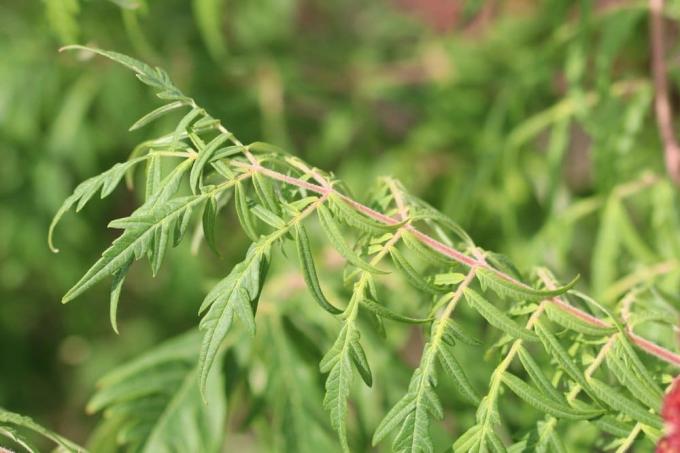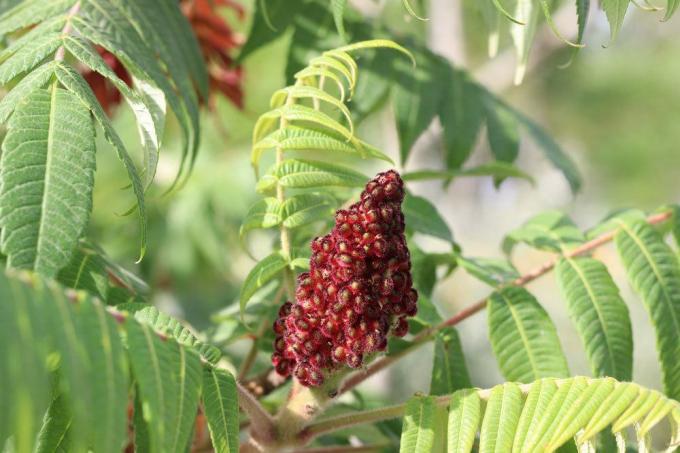
table of contents
- Is the vinegar tree poisonous?
- edibility
- Effect on people
- Effect on dogs
- Effect on cats
- Effect on small animals
- Effect on horses
The vinegar tree is a popular ornamental plant that presents itself in different varieties in the garden and draws attention to itself with unique inflorescences. These give the plant the name Hirschkolbensumach, because together with the branches they are reminiscent of the antlers of a deer. The name of the plant comes from the taste of the fruits, which are reminiscent of vinegar. That is why many gardeners wonder whether the vinegar tree is poisonous or not.
Is the vinegar tree poisonous?
Whether the buck umach is poisonous can be determined from the ingredients that are present in the plant. Because of this, the plant is called slightly poisonous classified, especially the following parts of the plant
- leaves
- fruit
- bark
- root
- wood
- Milky juice
Only the blossoms of the vinegar tree can be classified as non-toxic, as they contain extremely small amounts of toxic components and cannot cause any symptoms. In contrast to the rest of the plant, because in all parts there are correspondingly high amounts of the ingredients:
- Tannins
- Flavonoids
- Triterpenes
- Ellagic acid
- Cell sap (strongly acidic)
The cell sap, which is responsible for the characteristic vinegar taste, should be mentioned here. The tannins are one of the components of the plant, which occurs in large quantities and, together with the cell sap, ensures the poisonous effect. The triterpenes should also be mentioned here, which are mainly found in the milky sap of the plant, which runs through the entire plant. This makes the milky sap one of the greater dangers of the vinegar tree, as it is in a Most of the parts of the plant are located and can get onto the body or be ingested very quickly can. The flavonoids contained, on the other hand, are the substances that give the plant its characteristic color. The non-toxic flowers contain the following substances:
- vitamin C
- Fruit acids
- Flavonoids

edibility
As already mentioned, the flowers pose no danger to humans or animals. Because of their aroma, they are even consumed. At this point, the fact must also be mentioned that the actually poisonous fruits can be consumed when processed. For centuries these were used by the North American natives for the production of a cooling drink, which is now known as "Indian Lemonade". In the past, the fruits were simply consumed as they were refreshing due to the sour vinegar taste. They were also part of the vinegar production. The fruits only contain a slightly higher proportion of toxins, which makes it possible to consume them. Nevertheless, consumption harbors potential dangers, which will be discussed in the next section.
tip: Rhus typhina can easily be confused with other species within the genus, especially the Gerber Sumac (Rhus coriaria), which is also is known under the names Färberbaum and Spürz-Sumach and has the same toxicity except for different flavors. The oak-leaved poison sumac (bot. Rhus toxicodendron) and the climbing poison sumac (bot. Rhus radicans), which do not really resemble the vinegar tree in appearance.
Effect on people
Despite its ingredients, the vinegar tree is not a real problem, as large quantities of the fruits or leaves have to be consumed before poisoning occurs. However, you should be careful not to consume too much of the fruit. Although these are enjoyable, children, weakened, sick and elderly people in particular suffer from the tannins and acids they contain. The following symptoms are typical:
- nausea
- Vomit
- diarrhea
- Stomach and intestinal pain
- Kidney pain
- Liver pain
- Dizzy spells
- headache
- Liver damage
You should be particularly careful with the milky juice, as it can cause painful inflammation on the skin. If this gets on your mucous membranes, for example your eyes, it can lead to inflammation. Children in particular should not be allowed to come into contact with the plant for too long, as the youngsters like to wipe their hands on their eyes. At this point the vinegar tree becomes poisonous and you must see a doctor as a precaution to prevent possible consequential damage. Also give fresh water to get the ingredients out of the body.
Effect on dogs
As a dog owner, you don't have to worry that much. The plant is also for the four-legged friends easypoisonous, but in most cases dogs do without the plant parts. They often don't even play with the twigs, but this is not the case with puppies. Dogs need to eat a large amount of plant parts from the vinegar tree before they experience any health problems from the vinegar tree. The following symptoms can be:
- Vomit
- diarrhea
- nausea
- Irritation of the gastrointestinal tract
More dangerous is the milky sap, which can get on the mucous membranes after chewing on the leaves, which can lead to pain and inflammation.
tip: Not only dogs can injure themselves through contact with milk juice, as it is poisonous for all animals, no matter how big or small they are. Animals with little fur, such as the Sphinx cat or the Chinese crested dog, are particularly susceptible to the milky sap, as their small amount of fur does not really protect against the ingredients.
Effect on cats
If you are a cat owner, you should take care of your house tiger. Compared to other animals, cats have a significantly poorer sense of taste, which does not make the animals shy away from eating poisonous plants. Since the senses of animals are different from those of dogs, they use their mouths to explore their surroundings, much like small children. Since the vinegar tree is mainly poisonous when consumed, this poses a major problem for cat owners, as the dangers of ingestion are quite high. If your cat has been poisoned by Rhus typhina, this is shown by symptoms that are similar to those of dogs. Milky sap, which affects the mucous membranes, poses a greater danger.
The reason for this is the cleaning behavior of the animals. Since house tigers clean themselves intensively and touch their eyes and nose with their previously licked paws, severe irritation quickly occurs. In most cases, these are the cause of complaints from contact with the plant.
Effect on small animals
Small animals, like children and cats, are particularly susceptible to the tannins and acids within the plant parts of Rhus typhina. Some species tolerate eating or gnawing on the branches much worse than others:
- Guinea pig
- Chinchillas
- hamster
Mice, hares, rabbits and rats should also refrain from eating them, but they can tolerate them Pets significantly larger amounts of the plant. However, the symptoms can be quite severe if large amounts of the plant are consumed:
- stomach pain
- Intestinal irritation
- diarrhea
- Fits of weakness
Of course, going to a veterinarian is recommended here, as small animals are much more sensitive creatures than house tigers or man's best friend. Do not forget to take a piece of the plant with you to the doctor, as this enables a precise analysis.
Effect on horses
Make sure that horses do not consume the leaves of the vinegar tree. Since these are within reach and above all at the height of the animals, they are quickly tried, which can lead to a multitude of problems. Horses are poorly armed against the ingredients, especially the acids and tannins, and get sick very quickly, even if the amounts of the plant material consumed are small. The symptoms of consumption are as follows:
- nausea
- Vomit
- Stomach discomfort
- diarrhea
- severe colic
The symptoms become more difficult depending on the amount of the poisonous vinegar tree consumed. However, since horses have an excellent sense of taste and prefer sweet foods, really large amounts are rarely consumed. Sometimes the animals can have slight inflammation of the eyes or nose when chewed leaves or fruits touch the mucous membranes. If there is any suspicion of poisoning from the vinegar tree, you should also consult a veterinarian here. Due to the size of the mounts, they have to consume large amounts for a really intense poisoning, unlike cats or small animals.

Note: Please note that this article does not in any way replace a visit to the doctor. There is no guarantee that medical statements are correct.
You will find detailed information on first aid in the event of poisoning and important information on poison control centers here.

